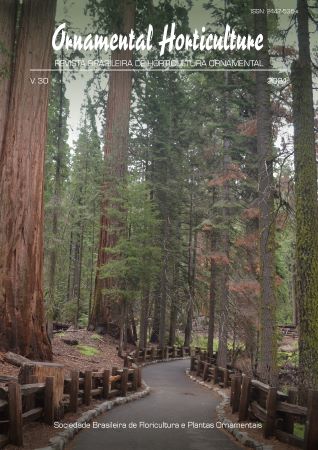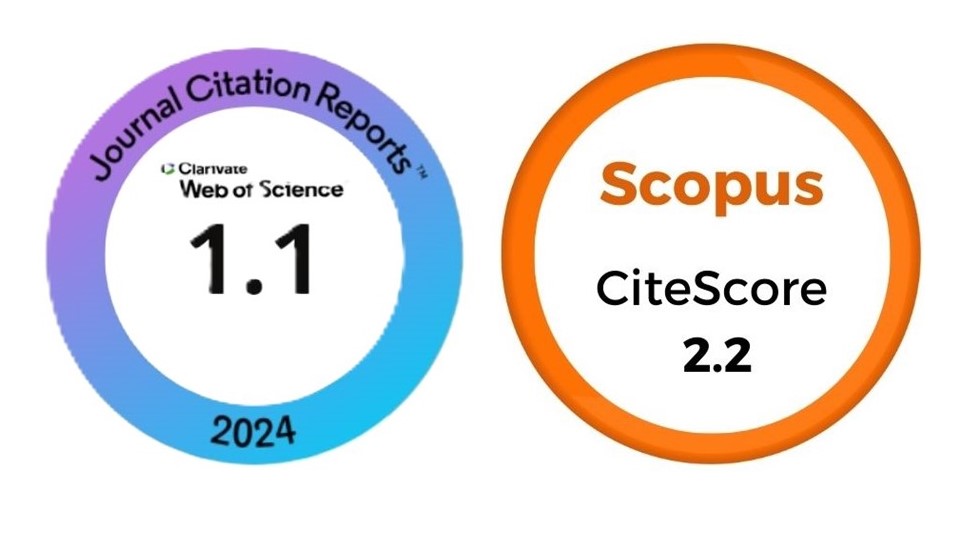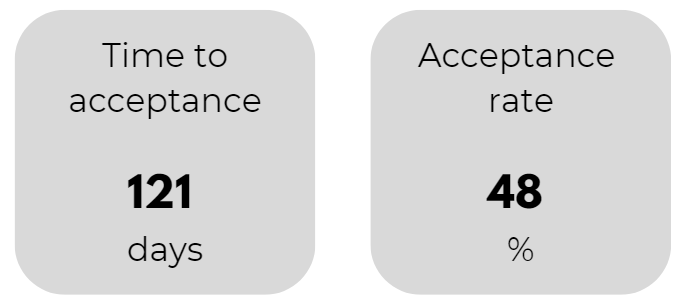Resposta de cultivares de cravo suscetíveis à aplicação de tiamina como indutor de resistência à murcha vascular causada por Fusarium oxysporum f. sp. dianthi
DOI:
https://doi.org/10.1590/2447-536X.v30.e242633Palavras-chave:
Compostos fenólicos, Dianthus caryophyllus, Flavonoides, Resistência induzidaResumo
A Colômbia é um dos principais produtores de cravos do mundo. No entanto, sua produção tem sido afetada pela murcha vascular causada pelo patógeno Fusarium oxysporum f. sp. dianthi. Em estudos anteriores, a tiamina foi proposta como um potencial indutor de resistência para esta doença, em condições de cultivo em casa de vegetação. No entanto, as condições específicas para sua aplicação devem ser estudadas ao aplicá-lo em condições comerciais. Nesse sentido, o objetivo deste trabalho foi avaliar o efeito na incidência de doenças da aspersão foliar de soluções de tiamina em diferentes concentrações entre algumas cultivares de cravo susceptíveis. Para isso, foram realizados dois ensaios in vivo, utilizando pulverização foliar de tiamina como tratamento antes da inoculação com o patógeno Fod, a seguir foram feitas medições de incidência, severidade e teor de compostos fenólicos e flavonoides. Verificou-se que a aplicação de tiamina, nas 4 concentrações avaliadas, apresenta diminuição estatisticamente semelhante na incidência e gravidade da doença. Esses resultados foram verificados por meio de análise estatística multivariada. Além disso, verificou-se que a aplicação de tiamina na concentração de 1mmol*L-1 apresenta resposta positiva na redução dos efeitos da doença em três cultivares suscetíveis. Os resultados sugerem que a tiamina tem potencial para ser aplicada como técnica no manejo integrado de doenças no setor produtivo.
Downloads
Referências
AHN, I.P.; KIM, S.; LEE, Y.; SUH, S. Vitamin B1-Induced priming is dependent on hydrogen peroxide and the NPR1 gene in Arabidopsis 1. Plant Physiology, v.143, p.838-848, 2007. https://doi.org/10.1104/pp.106.092627
ATIF, M.; PERVEEN, S.; PARVEEN, A.; MAHMOOD, S.; SAEED, M.; ZAFAR, S. Thiamine and indole-3-acetic acid induced modulations in physiological and biochemical characteristics of maize (Zea mays L.) under arsenic stress. Sustainability, v.14, n.20, p.1-28, 2022. https://doi.org/ 10.3390/su142013288
BAHUGUNA, R.N.; JOSHI, R.; SHUKLA, A.; PANDEY, M.; KUMAR, J. Thiamine primed defense provides reliable alternative to systemic fungicide carbendazim against sheath blight disease in rice (Oryza sativa L.). Plant Physiology and Biochemistry, v.57, p.159-167, 2012. https://doi.org/10.1016/j.plaphy.2012.05.003
BOUBAKRI, H. Induced resistance to biotic stress in plants by natural compounds: Possible mechanisms. In HOSSAIN, M.A.; LIU, F.; BURRITT, D.J.; FUJITA, M.; HUANG, B. (Eds.). Priming-mediated stress and cross-stress tolerance in crop plants. London: Academic Press Elsevier Inc., 2020. p.79-99.
BOUBAKRI, H.; POUTARAUD, A.; WAHAB, M.A.; CLAYEUX, C.; BALTENWECK, R.; STEYER, D.; MARCIC, C.; MLIKI, A.; SOUSTRE, I. Thiamine modulates metabolism of the phenylpropanoid pathway leading to enhanced resistance to Plasmopara viticola in grapevine.
BMC Plant Biology, v.13, n.1, p.1-15, 2013. https://doi.org/10.1186/14712229-13-31
DEVI, B.; SINGH, G.; DASH, A.K.; GUPTA, S.K. Chemically induced systemic acquired resistance in the inhibition of French bean rust. Current Plant Biology, v.23, p.1-10, 2020. https://doi.org/ 10.1016/j.cpb.2020.100151
DUMANOVIĆ, J.; NEPOVIMOVA, E.; NATIĆ, M.; KUČA, K.; JAĆEVIĆ, V. The significance of reactive oxygen species and antioxidant defense system in plants: A Concise Overview. Frontiers in Plant Science, v.11, p.1-13, 2021. https://doi.org/10.3389/fpls.2020.552969
HAMADA, A.M.; FATEHI, J.; JONSSON, L.M.V. Seed treatments with thiamine reduce the performance of generalist and specialist aphids on crop plants. Bulletin of Entomological Research, v.108, n.1, p.84-92, 2018. https://doi.org/doi.org/doi.org/10.1017/S0007485317000529
JIA, X.; QIN, H.; BOSE, S.; LIU, T.; HE, J.; XIE, S.; YE, M.; YIN, H. Proteomics analysis reveals the defense priming effect of chitosan oligosaccharides in Arabidopsis-PstDC3000 interaction. Plant Physiology and Biochemistry, n.149, p.301-312, 2020. https://doi.org/10.1016/j.plaphy.2020.01.037
KHEYRI, F.; TAHERI, P.; JAFARINEJAD, S. Thiamine and Piriformospora indica induce bean resistance against Rhizoctonia solani: The role of polyamines in association with iron and reactive oxygen species. Biological Control, v.172, p.1-13, 2022. https://doi.org/10.1016/j.biocontrol.2022.104955
KHEYRI, K.; TAHERI, P. The role of biological and chemical inducers in activating bean defense responses against Rhizoctonia solani. Physiological and Molecular Plant Pathology, v.116, p.1-14, 2021. https://doi.org/doi.org/10.1016/j.pmpp.2021.101718
MARTÍNEZ-GONZÁLEZ, A.P.; COY-BARRERA, E.; ARDILA, H.D. Extraction and analysis of apoplastic phenolic metabolites in carnation roots and stems (Dianthus caryophyllus L.). Revista Colombiana de Química, v.51, n.1, p.3-13, 2022. https://doi.org/10.15446/rev.colomb.quim.v51n1.99258
MADANY, M.; ZINTA, G.; ABUELSOUD, W.; HOZZEIN, W.; SELIM, S.; ASARD, H.; ELGAWAD, H. Hormonal seed-priming improves tomato resistance against broomrape infection, Journal of Plant Physiology, v.250, p.1-13, 2020. https://doi.org/10.1016/j.jplph.2020.153184
PÉREZ MORA, W.; MELGAREJO, L.M.; ARDILA, H.D. Effectiveness of some resistance inducers for controlling carnation vascular wilting caused by Fusarium oxysporum f. sp. dianthi. Archives of Phytopathology and Plant Protection, v.54, n.13–14, p886-902, 2021. https://doi.org/10.1080/03235408.2020.1868734
PÉREZ MORA, W.; CASTILLEJO, M.A.; JORRÍN NOVO, J.; MELGAREJO, L.M.; ARDILA, H.D. Thiamine-induced resistance in carnation against Fusarium oxysporum f. sp dianthi and mode of action studies based on the proteomics analysis of root tissue. Scientia Horticulturae, v.323, p.112549, 2024. https://doi.org/10.1016/j.scienta.2023.112549
ROMERO-RINCÓN, A.; MARTÍNEZ, S.T.; HIGUERA, B.L.; COY, E.; ARDILA, H.D. Flavonoid biosynthesis in Dianthus caryophyllus L. is early regulated during interaction with Fusarium oxysporum f. sp. dianthi. Phytochemistry, v.192, p.1-14, 2021. https://doi.org/10.1016/j.phytochem.2021.112933
SALWAN, R.; SHARMA, M.; SHARMA, A.; SHARMA, V. Insights into plant beneficial microorganism-triggered induced systemic resistance. Plant Stress, v.7, p.1-11, 2023. https://doi.org/10.1016/j.stress.2023.100140.
SANABRIA, K.; PÉREZ, W.; ANDRADE, J.L. Effectiveness of resistance inductors for potato late blight management in Peru. Crop Protection, v.137, p.1–7, 2020. https://doi.org/10.1016/j.cropro.2020.105241
SANTOS-RODRÍGUEZ, J.; COY, E.; ARDILA, H.D. Mycelium dispersion from Fusarium oxysporum f. sp. dianthi elicits a reduction of wilt severity and influences phenolic profiles of carnation (Dianthus caryophyllus L.) roots. Plants, v.10, p.1-20, 2021. https://doi.org/https://doi.org/10.3390/plants10071447
SATHIYABAMA, M.; INDHUMATHI, M.; MUTHUKUMAR, S. Chitosan nanoparticles loaded with thiamine stimulate growth and enhances protection against wilt disease in Chickpea. Carbohydrate Polymers, v.212, p.169-177, 2019. https://doi.org/10.1016/j.carbpol.2019.02.037
SINGH, P.; SINGH, J.; RAY, S.; RAJPUT, R.S.; VAISHNAV, A.; SINGH, R.K.; SINGH, H.B. Seed biopriming with antagonistic microbes and ascorbic acid induce resistance in tomato against Fusarium wilt. Microbiological Research, v.237, p.1-13, 2020. https://doi.org/10.1016/j.micres.2020.126482
TORKY, Z.A. Vitamin B mediated priming of disease resistance and defense responses to tobacco mosaic virus in Capsicum annuum L. plants. Journal of Antivirals & Antiretrovirals, v.8, n.2, p.35-53, 2016. https://doi.org/10.4172/jaa.1000133
TRADEMAP. 2022. Trade Statistics for International Business Development. Available on: <https://www.trademap.org/>. Accessed on: Dec 10th 2023.
VANEGAS-CANO, L.J.; MARTÍNEZ, S.T.; COY, E.; ARDILA, H.D. Plant hormones accumulation and its relationship with symplastic peroxidases expression during carnation-Fusarium oxysporum interaction. Ornamental Horticulture, v.28, n.1, p.49-59, 2022. https://doi.org/10.1590/2447-536X.V28I1.2412
WOLCAN, S.M.; MALBRÁN, I.; MOURELOS, C.A.; SISTERNA, M.N.; GONZÁLEZ, M.P.; ALIPPI, A.M.; NICO, A.; LORI, G.A. Diseases of Carnation. In: MCGOVERN, R.; ELMER, W.H. (Eds.). Handbook of Plant Disease Management. Cham: Springer International Publishing, 2018. p.317–378.
YIN, Y.; BI, Y.; LI, Y.; WANG, Y.: WANG, D. Use of thiamine for controlling Alternaria alternata postharvest rot in Asian pear (Pyrus bretschneideri Rehd cv. Zaosu). International Journal of Food Science and Technology, v.47, n.10, p.2190–2197, 2012. https://doi.org/10.1111/j.1365-2621.2012.03088.x
YONG-HONG, G.E.; CAN-YING, L.I.; JING-YI, L.; DAN-SHI, Z. Effects of thiamine on Trichothecium and Alternaria rots of muskmelon fruit and the possible mechanisms involved. Journal of Integrative Agriculture, v.16, n.11, p.2623-2631, 2017. https://doi.org/10.1016/S2095-3119(16)61584-8
ZHOU, J.; SUN, A.; XING, D. Modulation of cellular redox status by thiamine-activated NADPH oxidase confers Arabidopsis resistance to Sclerotinia sclerotiorum. Journal of Experimental Botany, v.64, n.11, p.3261-3272, 2013. https://doi.org/10.1093/jxb/ert166
Downloads
Publicado
Edição
Seção
Licença
Copyright (c) 2024 Walter Pérez Mora, Luz Marina Melgarejo, Harold Duban Ardila

Este trabalho está licenciado sob uma licença Creative Commons Attribution 4.0 International License.








